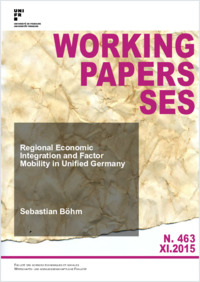Regional economic integration and factor mobility in unified Germany
BP2-STS
-
23.09.2015
37
English
The massive movement of capital and labor in opposite directions is the most striking characteristic of economic integration of Eastern and Western Germany. Beyond that, wage-setting behavior during the early years of unification and massive public social transfers have affected the transition path of the Eastern economy. In this paper, I set up a two-region open economy model with capital and labor mobility, wage-setting behavior, and public social transfers to explain major empirical trends of the German integration episode. I show that the model is able to replicate aggregate migration pattern in unified Germany and that wage-setting behavior has delayed labor productivity convergence between both German regions, whereas public social transfers have reduced the effect of wage setting on East-West net migration.
- Collections
- Faculty
- Faculté des sciences économiques et sociales et du management
- Language
-
- English
- Classification
- Economics
- Series statement
-
- Working Papers SES ; 463
- License
-
License undefined
- Identifiers
-
- RERO DOC 257529
- RERO R008298286
- Persistent URL
- https://folia.unifr.ch/unifr/documents/304774
Statistics
Document views: 191
File downloads:
- Document: 262
